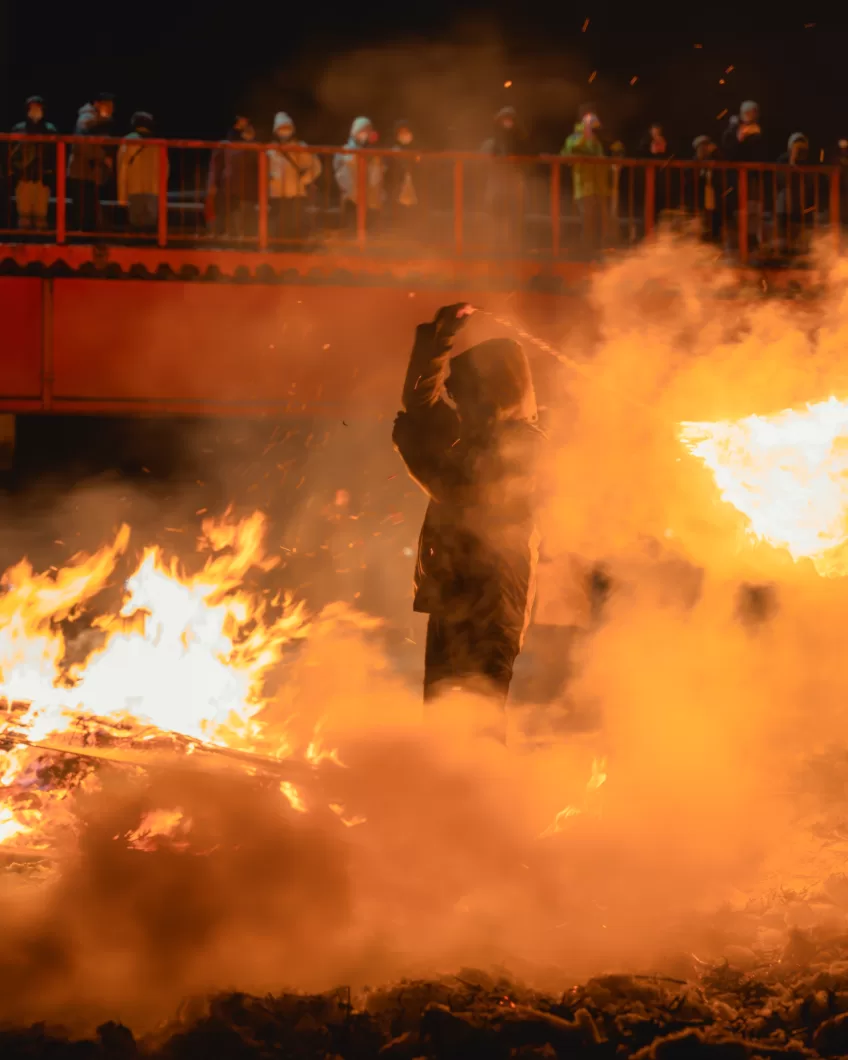
Winter is often an underrated season for Japan but we think the frosty months are well worth considering since there are fewer international travellers, budget-friendly flights and, most importantly, a whole host of unique winter festivals. We take a look at some of the country’s best winter festivals located in the northern parts of Japan and as a cherry on top, we’ve included our itinerary at the end of the post which traverses all festivals in one trip.
Sapporo Snow Festival
Date: February 4-11th
Location: Sapporo

Perhaps the only festival on the list that doesn’t need introducing, Sapporo Snow Festival is Japan’s largest and most well-known winter festival. Attracting nearly 2 million visitors a year to Hokkaido’s capital city with stunning snow and ice sculptures as well as family-friendly fun snow activities. In 2024, the festival will see a full return and will re-open the popular Tsudome venue and food stalls which were cancelled the previous year.
Tip: There are three venues for the Sapporo Snow Festival all located around the city of Sapporo: Odori, Susukino and Tsudome. For more information check out our full guide.
How to get there: Odori and Susukino venues can be easily reached using the respective underground stations. To visit Tsudome you can catch the underground to Sakaemachi station and walk 15 minutes or catch the shuttle bus outside the station.
Hirosaki Castle Snow Lantern Festival
Date: February 9-12th
Location: Hirosaki


Hirosaki is a small city located in the tippy-top of Tohoku and is perhaps better known for its sakura festival and heart-shaped sakura tree tops. But come winter, the city’s central park plays host to a magical winter festival with around 150 snow lanterns and kamakuras (igloos) built all around. In honour of its famed Sakura season, the surrounding castle moat and bank of trees also light up in a vibrant cherry pink.
Tip: Time your visit right after 4 pm as the park begins to illuminate from the lights and snow lanterns.
How to get there: Hirosaki Castle is around 30 minutes by foot from Hirosaki train station. You can also catch a bus to Shiyakusho Mae (City Hall Bus Stop) and walk for 5 minutes.
hirosaki-kanko.or.jp/en/edit.html?id=snow_lantern_festival
Namahage Sedo Festival
Date: February 9-11th
Location: Oga


The Namahage Sedo Festival is what you get when you combine a 900-year-old Shinto ritual and local Japanese folklore. The Namahage are knife-wielding demon ogres that appear in the night to snatch naughty children away – at least that’s the story the parents of Oga town would tell to their misbehaving children. For three days in February, you can visit Shinzan shrine and see the Namahage descend from the forests, wave fire torches and wreak havoc on the town’s people. Trust us, it’s great fun!
Tip: Arrive earlier than the start of the festival as there’s a show inside one of the halls you can watch which explains why the Namahage visit (only in Japanese).
How to get there: To reach Shinzan shrine you can either drive or catch a shuttle bus from Oga Train Station or Oga Onsen Village. You can buy a pre-application ticket which reserves a seat on the bus or you can buy a bus ticket at the station (while there is still space).
Hiburi Kamakura
Date: February 14th
Location: Kakunodate


Ever swung a scorching fireball out in the heavy snow? No? Well, you can try your hand at exactly that at the Hiburi Kamakura festival. Locals wrap coal in straw sacks known as hiburi before setting it alight and swinging the flames around themselves. The dicey tradition occurs in Kakunodate and is believed to purify bad luck and energy for the year ahead. Visitors are encouraged to join in and give the tradition a go but if you prefer to watch from a distance it’s still quite the spectacle to watch.
Tip: When swinging the fireball be sure to swing with enough momentum to keep the fireball a safe distance from yourself. Too slow and the smoke will start getting in your eyes which, as you can imagine, is not too nice. The festival organisers are also on hand to help and teach you how to do it safely. The festival starts at 5 pm and lasts around 2 hours.
How to get there: You might spot several fireballs around Kakunodate town but the main area is located by the river banks near Furushiro Bridge. It’s about a 30-minute walk from Kakunodate train station or catch the bus outside the train station.
city.semboku.akita.jp/sightseeing/spot/07_hiburi.html
Yokote Kamakura Festival
Date: February 15-16th
Location: Yokote

Yokote’s Kamakura Festival is steeped in long traditions, dating almost 500 years ago. What makes this festival unique compared to the rest is the giant kamakuras (snow igloos) that pop up all around the city. Each of the kamakuras houses an altar dedicated to the water deity. Locals pray to these alters for a good year of water and weather for their lands and crops. Later in the evening, you’ll find children inside the kamakuras inviting you inside to serve grilled mochi and amakaze (non-alcoholic sweet rice wine).
Tip: Don’t miss the thousands of tiny candle-lit kamakuras by the riverbank and outside Minami Elementary School. Lights are kept on until 10 pm.
How to get there: There are shuttle busses which run around the city on the day but we recommend walking if you have the time as you discover beautiful snow sculptures and kamakuras everywhere.
tohokukanko.jp/en/attractions/detail_10012.html
2-week winter festivals in Japan itinerary
(1 day to spare)
- Feb 3rd-5th – Tokyo: 2 days
- Feb 5-7th – Sapporo: 2 days
- Feb 8th – Hakodate: 1 day
- Feb 9-10th – Hirosaki: 2 days
- Feb 11-14th – Akita: 4 days
- Feb 11th – Oga: day trip
- Feb 14th – Kakunodate: day trip
- Feb 15th – Omagari/Yokote: 1 day
- Feb 16th – Tokyo: 1 day
Now you know the awesome winter festivals in Japan, here’s an itinerary that covers them all in 2 weeks. It’s tight due to the relatively close festival dates but it’s doable. Please be mindful that festival dates may vary year on year which may affect the itinerary.
Most travellers will land in Tokyo so that’s where we’re starting the itinerary from but you can also opt to start from Osaka if you find cheaper flights or would prefer a few days exploring there instead.
From there you will fly to Sapporo and spend a couple of days to see the Sapporo Snow Festival and other places around the city. We opted to then travel down to Hakodate as it’s a unique place in Japan that has a very Western feel to it thanks to the trade that occurred in this area. You can opt to spend more time in Sapporo or other parts of Hokkaido instead but you will then need to fly from Sapporo to Aomori.
Our itinerary chose to use the ferry which takes 4 hours to travel from Hakodate over to the main island again, landing in Aomori. But because we took a late ferry we didn’t have any time to explore Aomori and travelled straight over to Hirosaki. If you have the time we would recommend squeezing a visit to Aomori which is an area famous for its apples – we’ve heard they do excellent cider!
The following day we spent the whole time at Hirosaki Snow Lantern Festival but there’s lots to explore around the city so it’s easy to spend a day here. We recommend staying another night as you’ll also want to catch the night illumination.
From Hirosaki, it’s a straight train down to Akita. This is where we stayed for four nights as it was a reasonable location to travel out to Oga for the Namahage Sedo Festival and Kakundate’s Hiburi Kamakura. Of course, you can find accommodations closer to these two festivals but they were more expensive, almost booked out when we went to look and the quality of the hotels wasn’t quite as good as what we found in Akita.
You do have the option of staying more nights in Akita and doing a day trip out to Yokote but because it’s a 2-hour train and we knew we wanted to stay fairly late to see the night illuminations we decided to instead book a night stay at Omagari which is only 30 minutes away from Yokote. The ideal solution would be to stay at Yokote but accommodation is very limited and again by the time we started looking everywhere was already full.
To head back to Tokyo, or Osaka if that’s where you’re flying home from, the easiest option would be to head back to Akita’s airport and fly.

 Hello, we’re Eric and Sarah – a couple of travel photographers and creatives from the UK.
Hello, we’re Eric and Sarah – a couple of travel photographers and creatives from the UK.

